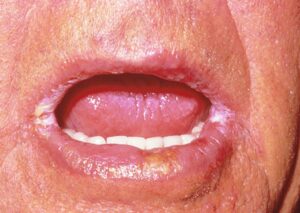What is it?
Angular cheilitis, also known as perleche or angular stomatitis, is a common inflammatory condition characterized by redness, fissuring, and inflammation at the corners of the mouth. It can be acute or chronic and is often associated with discomfort, pain, and difficulty in eating or speaking. Angular cheilitis can occur at any age but is more common in children, older adults, and individuals with certain predisposing factors.
Here are some key points about angular cheilitis:
- Etiology: Angular cheilitis is multifactorial, with various factors contributing to its development. Common causes and predisposing factors include:
- Fungal infections: Candida albicans, a yeast commonly found in the oral cavity, can proliferate in the moist environment of the corners of the mouth and contribute to the development of angular cheilitis, particularly in individuals with compromised immune function or poor oral hygiene.
- Bacterial infections: Secondary bacterial infections, particularly with Staphylococcus aureus or Streptococcus species, can occur in conjunction with fungal overgrowth and exacerbate the inflammatory process.
- Nutritional deficiencies: Deficiencies in essential nutrients such as iron, zinc, riboflavin (vitamin B2), or niacin (vitamin B3) can predispose individuals to angular cheilitis, as these nutrients play a role in maintaining healthy skin and mucosal integrity.
- Trauma or irritation: Excessive saliva production, lip licking, drooling, ill-fitting dentures, or chronic mouth breathing can lead to maceration and irritation of the skin at the corners of the mouth, creating a favorable environment for the development of angular cheilitis.
- Clinical Presentation: Angular cheilitis typically presents with the following signs and symptoms:
- Redness, erythema, and inflammation at the angles or corners of the mouth, often accompanied by fissuring, scaling, or crusting of the affected skin.
- Pain, burning, or discomfort, particularly with opening the mouth, eating, or smiling.
- Itching or stinging sensation in the affected area, especially in cases associated with fungal infections.
- Secondary bacterial infections may present with pus or exudate at the corners of the mouth, along with fever or lymphadenopathy (enlarged lymph nodes) in severe cases.
- Diagnosis: Diagnosis of angular cheilitis is usually based on clinical examination and history of characteristic signs and symptoms. Laboratory tests such as fungal culture or microscopy may be performed to identify the underlying cause, particularly in cases suspected of fungal infection or secondary bacterial involvement.
- Treatment: Treatment of angular cheilitis aims to alleviate symptoms, resolve inflammation, and eradicate the underlying cause. Management options may include:
- Topical antifungal agents such as clotrimazole or miconazole cream to treat fungal infections.
- Topical or systemic antibiotics to address secondary bacterial infections, particularly in cases of purulent discharge or fever.
- Emollients or barrier creams to moisturize and protect the affected skin from further irritation or maceration.
- Nutritional supplements or dietary modifications to address underlying deficiencies, particularly in cases associated with malnutrition or poor dietary intake.
- Correction of predisposing factors such as ill-fitting dentures, mouth breathing, or oral habits that contribute to the development of angular cheilitis.
- Prevention: Prevention of angular cheilitis involves maintaining good oral hygiene, avoiding lip licking or biting, and addressing predisposing factors such as nutritional deficiencies or oral habits. Regular dental check-ups and proper denture care can also help prevent recurrence of angular cheilitis in susceptible individuals.
In summary, angular cheilitis is an inflammatory condition characterized by redness, fissuring, and inflammation at the corners of the mouth. It can be caused by fungal or bacterial infections, nutritional deficiencies, or local irritation and is often associated with discomfort and pain. Prompt diagnosis and appropriate management, including treatment of underlying causes and predisposing factors, are essential for resolving angular cheilitis and preventing recurrence.

